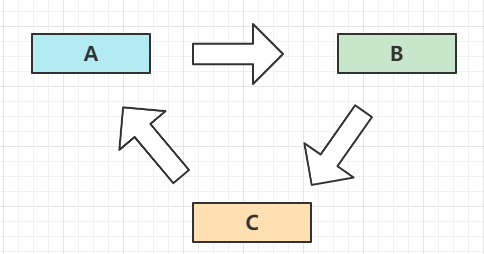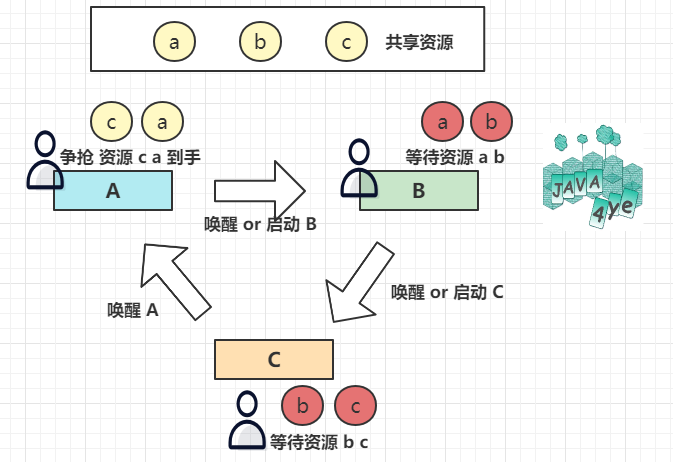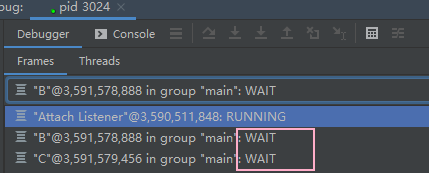面试题:三个线程按顺序打印 ABCABC
小伙伴们好呀,最近在重新复习,整理自己的知识库,偶然看到这道面试题:三个线程按顺序打印 ABCABC,尝试着做一下,才发现自己对线程还有好多地方不懂,蓝瘦……

思路
很明显,这里就涉及线程间相互通信的知识了。
而相互通信的难点就是要控制好,阻塞和唤醒的时机。
一. 这里就是 A 通知 B,B 通知 C , C 通知 A

三. 等待的方式大致分为两种
- wait 方法 (Object native 方式 )
- LockSupport.park 方式 ( Unsafe native 方式 )
四. 唤醒的方式
- notify,notifyAll 方法 (Object native 方式 )
- LockSupport.unPark 方式 ( Unsafe native 方式 )
五. 互斥条件
线程 A 先拿到资源 c,再拿资源 a ,[a 执行完后释放,并唤醒等待资源 a] 的 线程 B 线程 B 先拿到资源 a,再拿资源 b ,[b 执行完后释放,并唤醒等待资源 b] 的 线程 C 线程 C 先拿到资源 b,再拿资源 c ,[c 执行完后释放,并唤醒等待资源 c] 的 线程 A
所以得有 三个 共享资源 abc 来达到互斥条件
Synchronized 还是 ReentrantLock 都得建立 三个共享资源

使用 LockSupport ,如果要像上面这样子的思路去解答,就得注意 线程相互引用行成的循环依赖问题,这里借用 Spring 的思路 用 Map 巧妙化解。
或者做法2 通过 外部的成员变量,不断地去判断,unpark 线程 a b c
Synchronized 方式
private static class MySynchronized {
void printABC() throws InterruptedException {
class MyRunable implements Runnable {
private Object lock1;
private Object lock2;
private CountDownLatch countDownLatch;
public MyRunable(Object lock1, Object lock2) {
this.lock1 = lock1;
this.lock2 = lock2;
}
public MyRunable(Object lock1, Object lock2, CountDownLatch countDownLatch) {
this.lock1 = lock1;
this.lock2 = lock2;
this.countDownLatch = countDownLatch;
}
@Override
public void run() {
boolean running = false;
int count = 2;
while (count > 0) {
// C,A - > A 唤醒 B 线程
// A,B - > B 唤醒 C 线程
// B,C - > C 唤醒 A 线程 (最后一次执行时,唤醒 A 后,A 发现 count =0,就不执行了。
synchronized (lock1) {
synchronized (lock2) {
System.out.println(Thread.currentThread().getName());
count--;
// lock2 方法块执行结束前,唤醒其他线程。
lock2.notify();
}
// 线程执行完毕后
if (countDownLatch != null && !running) {
countDownLatch.countDown();
running = true;
}
try {
// 释放锁
lock1.wait();
} catch (InterruptedException e) {
}
}
}
System.out.println(Thread.currentThread().getName() + " over");
synchronized (lock2) {
// 唤醒其他线程。
lock2.notify();
}
}
}
CountDownLatch countDownLatch = new CountDownLatch(1);
CountDownLatch countDownLatch2 = new CountDownLatch(1);
Object a = new Object();
Object b = new Object();
Object c = new Object();
MyRunable ra = new MyRunable(c, a, countDownLatch);
MyRunable rb = new MyRunable(a, b, countDownLatch2);
MyRunable rc = new MyRunable(b, c);
Thread a1 = new Thread(ra, "A");
a1.start();
countDownLatch.await();
Thread b1 = new Thread(rb, "B");
b1.start();
countDownLatch2.await();
Thread c1 = new Thread(rc, "C");
c1.start();
}
}这里我借用 countDownLatch 去控制线程的启动流程,尽量不使用 Thread.sleep() 来实现,拿捏线程的执行,通信步骤。
写这个的时候,除了一开始思路不清晰外,还出现一个小状况,就是 程序执行完卡住了。

要记得在循环外再次唤醒其他线程,让他们走完方法。
ReentrantLock 方式
private static class MyReentrantLock {
int number = 6;
void printABC() {
ReentrantLock lock = new ReentrantLock();
Condition conditionA = lock.newCondition();
Condition conditionB = lock.newCondition();
Condition conditionC = lock.newCondition();
class MyRunnable implements Runnable {
ReentrantLock lock;
Condition condition1;
Condition condition2;
public MyRunnable(ReentrantLock lock, Condition condition1, Condition condition2) {
this.lock = lock;
this.condition1 = condition1;
this.condition2 = condition2;
}
@Override
public void run() {
int count = 2;
while (count > 0) {
lock.lock();
try {
String name = Thread.currentThread().getName();
if (
number % 3 != 0 && "A".equals(name)
|| number % 3 != 2 && "B".equals(name)
|| number % 3 != 1 && "C".equals(name)
) {
condition1.await();
}
System.out.println(name + " : " + number);
number--;
count--;
condition2.signal();
} catch (InterruptedException e) {
e.printStackTrace();
} finally {
lock.unlock();
}
}
}
}
new Thread(new MyRunnable(lock, conditionC, conditionA), "A").start();
new Thread(new MyRunnable(lock, conditionA, conditionB), "B").start();
new Thread(new MyRunnable(lock, conditionB, conditionC), "C").start();
}
}Synchronized 会了之后,这个也很简单了。
就是上锁的地方换成 lock.lock();,把三个共享资源换成 lock.newCondition();
然后思考一下阻塞条件 condition1.await() 。
毕竟 打印 和 唤醒 的操作总是在一起的。

LockSupport 方式
这里我写了两种方法
private static class MyLockSupport {
volatile int number = 6;
void printABC() throws InterruptedException {
class MyRunnable implements Runnable {
@Override
public void run() {
int count = 2;
while (count > 0) {
LockSupport.park(this);
System.out.println(Thread.currentThread().getName());
count--;
}
}
}
Thread a = new Thread(new MyRunnable(), "A");
Thread b = new Thread(new MyRunnable(), "B");
Thread c = new Thread(new MyRunnable(), "C");
a.start();
b.start();
c.start();
while (number > 0) {
if (number % 3 == 0) {
LockSupport.unpark(a);
} else if (number % 3 == 2) {
LockSupport.unpark(b);
} else {
LockSupport.unpark(c);
}
number--;
LockSupport.parkNanos(this, 200 * 1000);
// LockSupport.parkUntil(this,System.currentTimeMillis()+3000L);
}
}
// 用 map 解决线程循环依赖的问题
void printABC2() throws InterruptedException {
class MyRunnable implements Runnable {
Map<String, Thread> map;
public MyRunnable(Map<String, Thread> map) {
this.map = map;
}
@Override
public void run() {
int count = 2;
String name = Thread.currentThread().getName();
String key = "A".equals(name) ? "B" : "B".equals(name) ? "C" : "A";
while (count > 0) {
if (
number % 3 == 0 && "A".equals(name)
|| number % 3 == 2 && "B".equals(name)
|| number % 3 == 1 && "C".equals(name)
) {
System.out.println(name);
count--;
number--;
LockSupport.unpark(map.get(key));
}
LockSupport.park(this);
}
LockSupport.unpark(map.get(key));
}
}
Map<String, Thread> map = new HashMap<>();
Thread a = new Thread(new MyRunnable(map), "A");
Thread b = new Thread(new MyRunnable(map), "B");
Thread c = new Thread(new MyRunnable(map), "C");
map.put("A", a);
map.put("B", b);
map.put("C", c);
a.start();
b.start();
c.start();
}
}LockSupport 我也是第一次用,它使用起来也很方便,就单纯的 阻塞和唤醒线程 ,对应 park 和 unPark 方法。
它不要求你像 wait 那样子,必须写在 Synchronized 代码块里,被 Monitor 监视才行。
但同时,也意味着你必须控制好这个 锁的范围 。
你可以自由阻塞代码,在具备某个条件时,唤醒特定的线程,让它继续执行。
实际上,上面 ReentrantLock 中的 Condition await 方法,底层就是调用 LockSupport 的 park 方法。
这也是我开头说的通信大致分为两种方式的原因。
方法一中,我是用 parkNanos 阻塞一段时间,然后就继续运行,也算是取巧不用 Thread.Sleep 了吧
方法二 我比较喜欢,思路也是同开头两种,打印完唤醒其他线程。
over!下文见
